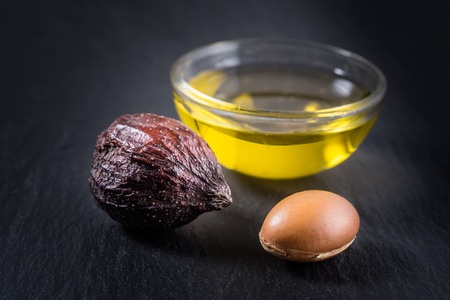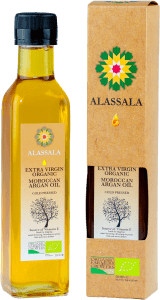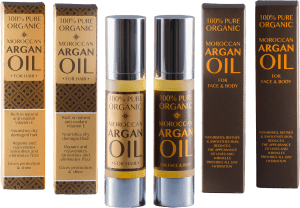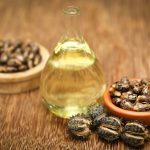
Argan Oil is not as well known as olive oil but deserves better press. Suppliers at food exhibitions regularly show off this plant oil because it has a number of useful nutritional, medicinal and cosmetic benefits. Indeed comparisons are regularly made with its more commercially ubiquitous relative, olive oil.
Argan oil is pressed from the kernels of the Argan tree (Argania spinosa L. family: Sapotaceae) which is only found growing in Morocco. Likewise, production of the oil is centred on south-western Morocco where it has a pivotal role in the economy (Charrouf and Guillaume, 1999). The tree is very drought resistant and lives for up to 200 years. It provides a lot of shade for animals and its leaves are regularly foraged. One of the environmental issues influencing cultivation of argan is that so many of the trees are being cut for firewood. Clearly there is a need for more plantations or strategic cultivation to stop encroachment of the Saharan sands.
Production Of Argan Oil.

The current method of production of virgin argan oil is very traditional but in recent years has been updated to improve the commercial viability of the oil (Charrouf et al., 2002; Matthäus et al., 2010). The traditional method requires hand picking the fruit, drying it in the sun and then removing the pericarp. The nut portion must be broken, still using rocks to release 3 or 4 kernels which are then air-dried in clay pots and slowly roasted. The kernels are crushed and kneaded into a paste with hot water. An oil and water emulsion is separated from the paste yielding a yellow-brown oil which has a slightly nutty taste, often described as hazelnut. This form is used in food preparation as a seasoning but recently, other forms have been diverted into the treatment of various skin (dermatological) conditions such as acne.
The compositional qualities are currently being unravelled. It is certainly a rich source of linoleic acid and antioxidants such as the tocopherols (Boukhobza and Pichon-Prum, 1988). The lipid profiles have been compared with olive oil for example (Rezanka and Rezankova, 1999; Khallouki et al., 2003). Feeding studies have been conducted to understand whether the oil as a supplement might reduce total plasma and LDL cholesterol levels, and even offer protection against atherosclerosis as was shown in a rat model (Berrougui et al., 2003). There is a study reported on reduction of atherosclerosis in men (Cherki et al., 2005). The benefits of argan oil have been reviewed in relation to cardiovascular disease (Cherki et al., 2006) and more generally in nutrition (Charrouf and Guillaume, 2008; Monfalouti et al., 2010).
Its fat composition is:
– 45% monounsaturated fatty acid (MUFA),
– 35% polyunsaturated fatty acid (PUFA)
– 20% saturated fatty acids (SFA)
The ratio of α-linolenic to linoleic acid is 0.003. There are a number of other compounds to be found. These are the phenolics (3.3mg/kg oil), tocopherols (637 mg/kg) and plant sterols (295 mg/kg). The sterols are schottenol (48%), spinasterol (44%), stigmasterol (4%) and Δ-7-avenasterol (4%) . The antioxidant effect is similar to that in olive oil (Masella et al., 2001).
Alassala Ltd market argan oil and derivatives which can be obtained via their web-site www.alassala.co.uk
They also supply the oil for cosmetic uses. 
Having tried this oil with just bread, there is a clean, slightly nutty taste and as a seasoning, it imparts a unique flavour similar to using other nut oils. I’d be interested to know more about this oil and if anyone is keen to market argan more prominently. There is still plenty of research needed to uncover its health benefits and maximise its potential.
References
Boukhobza M, Pichon-Prum N (1988). L’Arganier, ressource économique et médicinale pour le Maroc. Phytotherapy 27 pp. 21–26.
Charrouf Z, Guillaume D (1999). Ethnoeconomical, ethnomedical and phytochemical study of Argania spinosa (L.) Skeels. J. Ethnopharmacol 67 pp.7–14.
Charrouf, Z., Guillaume, D., Driouich, A. (2002). The argan tree, an asset for Morocco. Biofutur, 220, pp. 54–57 [in French].
Cherki, M., Berrougui, H., Drissi, A., Adlouni, A., Khalil, A. (2006) Argan oil: Which benefits on cardiovascular diseases? Pharmacol Res. 54 pp. 1–5.
Cherki, M., Derouiche, A., Drissi, A., El Messal, M., Bamou, Y., Idrissi-Ouadghiri, A., Khalil, A., Adlouni, A. (2005) Consumption of argan oil may have antiatherogenic effect by improving paraoxonase activities and antioxidant status: Intervention study in healthy men. Nutr. Metab. Cardiovasc. Dis. 15, pp.352–360.
Drissi, A., Girona, J., Cherki, M., Godas, G., Derouiche, A., El Messal, M., Saile, R., Kettani, A., Sola, R. Masana, L. Adlouni, A. (2004) Evidence of hypolipemiant and antioxidant properties of argan oil derived from the argan tree (Argania spinosa). Clin. Nutr. 23 pp. 1159-1166
Khallouki F, Younos C, Soulimani R, Oster T, Charrouf, Z. Spiegelhalder B, et al. (2003) Consumption of argan oil (Morocco) with its unique profile of fatty acids, tocopherols, squalene, sterols and phenolic compounds should confer valuable cancer chemopreventive effects. Eur. J. Cancer Prevent. 12 pp. 67–75.
Matthaüs B, Guillaume D, Gharby S, Haddad A., Harhar H, Charrouf Z. (2010) Effect of processing on the quality of edible argan oil. Food Chemistry, 120, pp. 426-432
Masella R, Giovannini C, Vari R, Di Benedetto R, Coni E, Volpe R, et al. (2001) Effect of dietary virgin olive oil phenols on low density lipoprotein oxidation in hyperlipidemic patients. Lipids 36 pp. 1195–202.
Monfalouti HE, Guillaume D, Denhez C, Charrouf Z. (2010) Therapeutic potential of argan oil: a review. J. Pharm Pharmacol. 62 pp. 1669-1675.


Leave a Reply